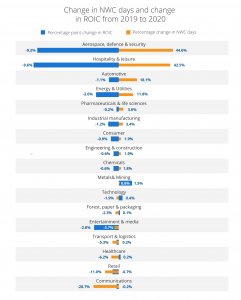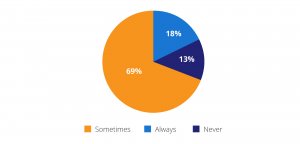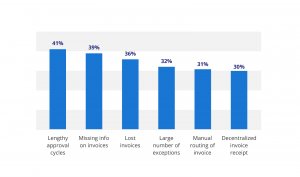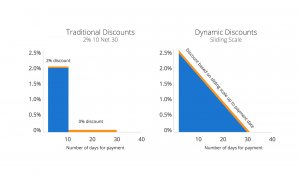As we mentioned in a previous blog, organizations of all sizes should treat cash flow management as a major priority, given its potential impact on long-term financial health.
The level of cash flow available to an organization can be measured by comparing current assets against current liabilities.
Examples of current assets include short-term investments, inventory, foreign currency, and prepaid expenses. Current liabilities range from accruals to current income tax liabilities, accounts payable, and short-term loans.
An organization’s procure-to-pay process can play a major role in improving cash flow management by optimizing the buyer’s cash conversion cycle without hurting their vendors’ cash flow needs.
According to PWC’s annual global Working Capital Study, net working capital days, the number of days required to convert working capital into revenue, increased to record highs during the pandemic. At industry level, many sectors saw significant deterioration in NWC days. The pandemic exposed a lack of adaptability to disruptive external events that still need to be addressed.

Most businesses aim to achieve a positive level of cash flow on a consistent basis, and by optimizing your procure-to-pay process, you will have a significantly better chance of achieving this. However, before undertaking any strategic changes to your procure to pay cycle, it’s important to note that there is a limit to how much positive working capital an organization should hold at any one time.
Finding the Right Balance in your Cash Flow Management
The main benefits of positive cash flow include improved liquidity, operational efficiency, and increased profits. However, holding an extremely high amount of cash is not always necessary.
Having too much cash on hand could mean there is more money than needed to fulfill operations, that cash is not being invested well, or that growth is being neglected in favor of maximizing liquidity. Such instances point to poor cash flow management.
As mentioned, your procure to pay process flow can profoundly affect your cash flow management and we’ve come up with six particular P2P strategies to help you on your way.
Procure-to-Pay Strategies to Improve Cash Flow Management
1. Effectively Manage Your Inventory
Optimizing inventory levels can have a major impact on cash flow management.
By ordering too much stock, you may be left with expired or out-of-season stock if it fails to sell. This leads to significant waste along with high storage and insurance costs.
In contrast, insufficient stock can lead to you missing out on sales and frustrating your customers, who may subsequently choose to look elsewhere.
In order to improve your cash flow management, departments should collaborate to accurately forecast the levels of inventory needed and establish common rules over how inventory is managed.
Investing in a procurement automation solution can greatly improve cash flow. A streamlined and centralized purchasing process leads to a far more rigorous authorization process, preventing maverick spending and ensuring stock is purchased from preferred vendors only.
2. Negotiate Early Payment Discounts with Preferred Suppliers
Vendors
Procurement and vendors often operate under very different agendas with regards to cash flow management. Procurement teams generally want to hold onto capital for as long as possible, whereas vendors want to speed up the time customers take to pay debts.
Satisfying the needs of both is not easily done; however, one particular strategy to address both needs is early payment discounts.
Early payment discounts work when vendors set specific discounts on invoices in return for payment on specific dates. However, the number of organizations capitalizing on early payment discounts is still quite low.

A major reason why many companies miss out on early payment discounts is that their procure-to-pay process is littered with manual inefficiencies that greatly increase invoice-to-payment times.

An automated accounts payable solution enables businesses to accelerate their invoice lifecycle and capture early payment discounts more regularly than before. Depending on the size of your organization, the savings could amount to thousands or even millions.
3. Automated Invoice Processing
Invoice processing can be costly and take a long time when done manually. A single invoice can cost as much as $15.97 and often take up to 45 days to process according to IOFM and often take up to 45 days to process.
Through Robotic Process Automation (RPA), however, organizations are significantly reducing invoice processing costs and lifecycles, which in turn, greatly improves their cash flow management.
The three key areas of improvement for these organizations that also affect working capital are:
Invoice Data Capture
This is the process of receiving an invoice from a vendor, extracting the relevant data, and entering it into an ERP or finance system. Traditionally, this process is expensive, manual, and often leads to data errors.
With an automated solution, technology like Optical Character Recognition (OCR) scans invoices that arrive via paper, electronic files, PDFs or emails and transfers the relevant data to a finance system, ready for matching.
Invoice Matching
Manually matching invoices, POs, and GRNs can lead to a number of challenges. Incorrect data, missing or damaged documents, and compliance issues often disrupt the invoice processing operation, increasing costs and time required. This affects the organization’s ability to pay vendors quickly and capture early payment discounts.
RPA can read relevant data from documents to match them automatically without any human interaction. As a result, employees save a considerable amount of time, limit human error, and greatly improve internal and external compliance.
Invoice Approval
Manual invoice approval processes lead to a number of issues that slow down the entire approval process. Slow approval processing times result in missed early payment discounts and sometimes late payment fees.
Pre-configured, automated invoice approval workflows, however, can manage the entire process with the help of RPA. Reminder notifications can be sent to speed up approval times, allowing invoices to be approved on the go through mobile applications. As a result, organizations benefit from early payment discounts far more often and thus improve their cash flow management.
Check out our blog on RPA for further insights into how it is transforming AP.
4. Dynamic Discount Management
Large organizations dealing with complex supply chains and numerous vendors often pay them using different payment terms. This is where a strategy called Dynamic Discount Management may be more beneficial than standard early payment discounts.
Dynamic Discount Management (DDM) works off supply and demand to determine the price that customers pay. With static early payment discounts, rates and payment dates are pre-determined. With dynamic discounting, however, buyers and vendors can collaborate on how and when discounts are offered and accepted.
Early payment discounts decrease as payment deadlines approach, enabling buyers and vendors to set and select discounts according to their business and financial requirements.
Procure-to-pay solutions give vendors greater visibility over invoice status, which increases their ability to offer more tailored discount rates for specific invoices. They also greatly improve the health of vendor relationships and supply chain efficiency.

DDM solutions are designed to reveal every possible savings opportunity by allowing buyers to view discount terms and upcoming due dates at any time.
5. Payments
For a long time, checks were by far the most common form of payment between organizations and vendors. However, organizations realize that by automating the payments process with electronic payments tools, they can significantly improve their cash flow management and capitalize on savings.
Electronic payments now make up 57% of B2B transactions. Two of the most popular types are Purchasing Cards (P-Cards) and Automated Clearing House (ACH). Organizations are increasingly targeting the payment process as part of digital transformation programs.
Purchasing Cards (P-Cards)
P-Cards are particularly easy to implement and also prove to be the most successful payment method for capturing discounts- hence their growing popularity.
Organizations are significantly improving their cash flow management with card payments that allow invoices to be paid and discounts captured on the same day.
Rather than having to pay vendors within a typical 30-day period with card payments, organizations often can hold onto capital for longer, giving them more options over how to conduct their operations.
Furthermore, the costs associated with printing and mailing checks is completely eliminated with a switch to P-Cards.
Automated Clearing House (ACH)
The ACH Network is an electronic system that enables organizations to electronically collect payments for either single-entry or recurring payments. This is done by directly debiting customer checking or saving accounts.
The payments are created after the customer gives the organization permission to debit directly from their account. The customer’s bank also takes the ACH transaction and batches it together with other ACH transactions to be sent out at regular times throughout the day.
The recipient’s bank account receives the transaction, thus reconciling both accounts and ending the process.
Typically, ACH transactions cost the originator 29 cents. This figure is in stark contrast to the typical cost of $3 per check payment.
ACH is quite clearly a far greater source of cash flow than paper checks, and organizations realizing this have increased ACH payments dramatically. In the two years since 2020, ACH b2b payments are up 33.2%.
According to data from The Association for Financial Professionals, an organization that sends 15,000 checks each month spends roughly $540,000 each year. In contrast, organizations that send payments through ACH are saving $487,800. These organizations are using these savings to re-invest back into the company.

**Assuming a company processes 15,000 payments a month.
6. Procurement and AP Alignment
At present, one-half of organizations capture early payment discounts some of the time and 16% never do. Organizations greatly improve their chances of receiving these discounts when their procurement and AP teams are tightly aligned. There are four key areas where the duo can work together to improve working capital:
- When negotiating, procurement needs to be informed of a realistic invoice lifecycle time by AP so that the discount is actually achievable.
- Once a discount has been negotiated, procurement needs to communicate the terms to AP and facilitate them to ensure that they successfully capture the discount.
- AP can also have a hand in sourcing, a task normally left to procurement, by fuelling the process with insights into the budget and input on matters regarding the suppliers’ accounting team.
- Procurement and AP are also a great pair when it comes to spend analytics, as both have a part to play in ordering, approving, and making payments. In order to make this partnership work, both teams are encouraged to develop common goals and find a way to track progress together.
Conclusion
Cash flow management should be considered a top priority by all organizations. After all, the level of working capital available is a strong indication of the long-term financial health of the business. Poor cash flow management can lead to organizational processes failing and an inability to expand. Your procure-to-pay process can have a huge impact on your cash flow. If you are interested in learning more about the procure-to-pay strategies that will significantly boost your working capital, checkout our Maximizing the ROI of P2P Automation whitepaper.


